2.4.1.1 Sheet quality
Durable and reliable air ducts are indispensable. Plastics score well with respect to these 2 criteria and are therefore ideally suited for ventilation applications. The following plastics are eligible for the manufacture of air ducts: PVC, PVC-C, HDPE, PP and PP-S. These plastics are chemical and corrosion resistant. This makes them also suitable for the extraction of aggressive vapours and steam.
PVC: PVC is extremely suitable for corrosive and aggressive conditions. Processing is done by gluing or welding.
PVC-C: PVC-C has a high chemical resistance and better temperature resistance than PVC. Processing is usually done by means of adhesives.
HDPE: HDPE is an inert material with good resistance to abrasive and corrosive substances. HDPE has a very smooth surface and is fairly impact resistant. Processing is done by welding.
PP and PP-S: The industrially used PP pipe is supplied in a light grey-beige colour RAL 7032. Thin-walled PP pipes are used for low pressure ventilation applications. PP-S is a difficult inflammable polypropylene with self-extinguishing properties. These pipes have a grey colour according to RAL 7037. Processing is done by welding.
2.4.1.2 Wall thickness
Plastic air ducts are manufactured with a wall thickness that depends on the largest duct side, as specified below. The air ducts are manufactured in such a way that they are sufficiently rigid to withstand deformations. The minimum wall thickness is based on the largest duct side:

2.4.1.3 Connections
The various plastics can be joined in the following ways:
- PVC: glued, welded or mechanically bonded;
- PVC-C: glued or mechanically connected;
- HDPE: welded or mechanically connected;
- PP: welded or mechanically connected;
- PP-S: welded or mechanically connected.
2.4.1.4 Cross-connections
Cross-connections between air ducts are provided by means of flanges formed from strips or angle sections which are properly attached to the ducts. The quality and thickness correspond to that of the material from which the air duct is manufactured. The mutual connection is made by means of fasteners and sealing tapes which are sufficiently chemically resistant and ensure sufficient airtightness. Cross-connections made by means of connectors are always welded in the case of internal construction. External connecting pieces are always welded in PP and HDPE applications and glued in PVC-C applications. In case of a duct side of 600 mm and larger, internal stiffening is also applied. Cross-connections, by means of expansion pieces in soft PVC, are welded to each other.
2.4.1.5 Longitudinal connections
Longitudinal connections between duct sections are generally welded.
2.4.1.6 Stiffening
Air ducts are designed to be sufficiently stiff that no troublesome deformations occur. Based on the application of the recommended minimum panel thicknesses according to 2.4.1.2, duct surfaces and duct pieces with a width > 300 mm are stiffened. If the width > 600 mm, surfaces with a wall area of more than 1 m² are additionally stiffened with welded-on and welded-on strips, or round spacers of equivalent plastic are placed in the duct pieces. If the width exceeds 1000 mm, surfaces with a wall area of more than 0.7 m² are also additionally stiffened.
2.4.1.7 Execution
For the execution possibilities of plastic air ducts we refer to 2.4.1.1. It is important that the choice of material is made in consultation with the supplier.
2.4.1.8 Dimensions
The nominal sizes of the air ducts are given in mm and refer to the external dimensions with a tolerance of ± 2 mm up to a side of 1000 mm. The dimensions are standardised according to the dimensions of rectangular metal ducts. See 2.1.1.6.
2.4.1.9 Visible work
If in an air technical installation a part of the air duct system has to be executed as "visible work", this will be executed as the other duct work, unless it has been mentioned otherwise in the specifications. With duct work designated as visible work, externally applied stickers and indications will be removed, while the required airtightness will be obtained by internal sealing. Additional measures within the framework of visible work do not normally belong to the standard execution.
2.4.1.10 Bends
Symmetrical bends
As far as the shape is concerned, symmetrical bends are always round, i.e. with an inside and an outside radius; (in the case of floor or wallrecesses where there is no room for an inside radius, an inside corner may be used or for production reasons); the inside radius is 100 mm or greater. In order to limit the resistance in a bend, bends are provided with blades. No blades are used for:
- bends of 45° or less;
- ducts with a width of 400 mm or less.
The position of the blades shall be determined according to the table below.

Elongated bends
In the case of elongated bends, the smallest duct width determines the number of blades, in accordance with the table above. The ratio for the position of the blades of the largest duct width is then equal to the ratio for the blades of the smallest duct width.
Blade design
The blades are made of single sheet metal. The sheet material is equal to the material from which the duct is made. The construction and fixing are of sufficient strength.
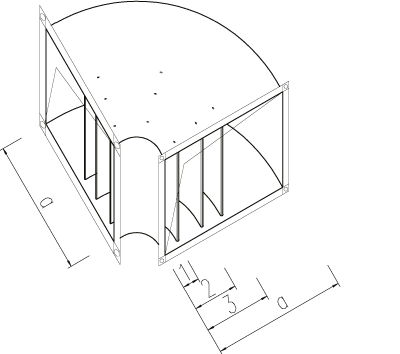
2.4.1.11 Adapters
The adapters are designed in such a way that the top angle may not exceed 60°.
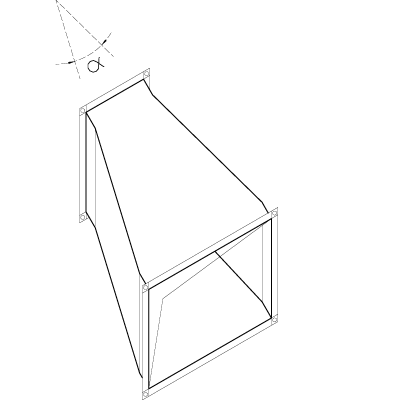
2.4.1.12 Branches
A branch (split off from a continuous main duct) can be achieved by means of a flowing fitting in a rectangular or round design. Aerodynamic aspects also determine the types, as shown in the illustrations below.
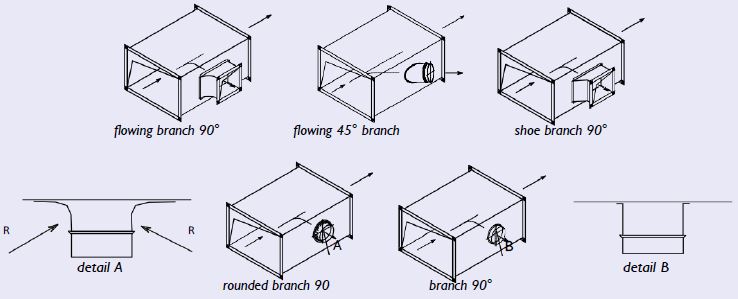
2.4.1.13 Splits
A split is a division of a main duct into two ongoing ducts.
Some examples of splits are:
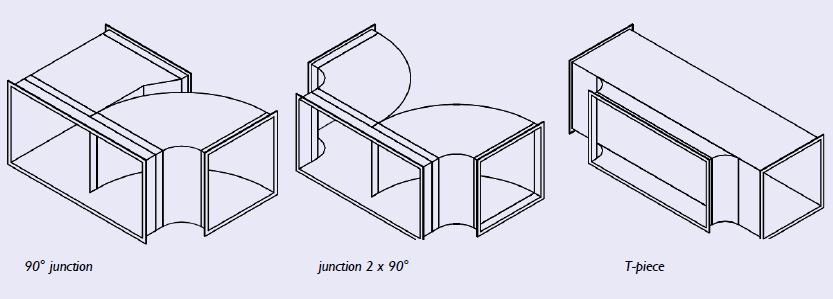
2.4.1.14 Adjustment valves
Adjustment valves are manually adjustable and serve to regulate an installation. They are provided with an appropriate locking device which also indicates the valve position. The damper blade, of the same material as the air duct, is made of a single sheet with a thickness of at least 4 mm up to a maximum blade width B of 300 mm and up to a maximum surface area of 0.09 m².
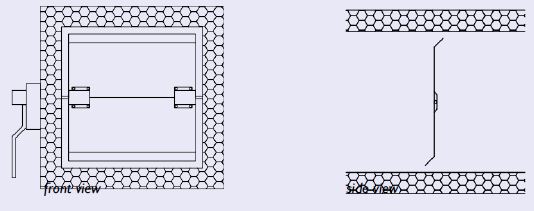
2.4.1.15 Smoke development, fire spread and flammability
PVC: flame-retardant, self-extinguishing according to DIN 4102/class BI
PVC-C: flame-retardant, self-extinguishing according to DIN 4102/class B1
HDPE: normally inflammable, not self-extinguishing according to DIN 4102/Class B2
PP: normally inflammable, not self-extinguishing according to DIN 4102/Class B2
PP-S: hardly inflammable, self-extinguishing according to DIN 4102/class B1
2.4.1.16 Operating temperature
The maximum operating temperature for PVC ducts is 60°C.
The maximum operating temperature for PVC-C ducts is 90°C.
The maximum operating temperature for HDPE is 70°C.
The maximum operating temperature for PP ducts is 100°C.
The maximum operating temperature for PP-S ducts is 100°C.

